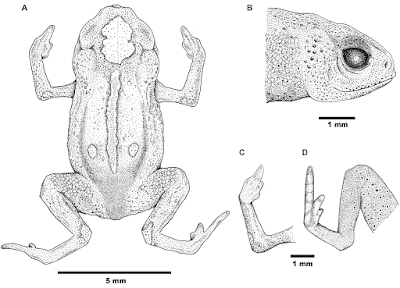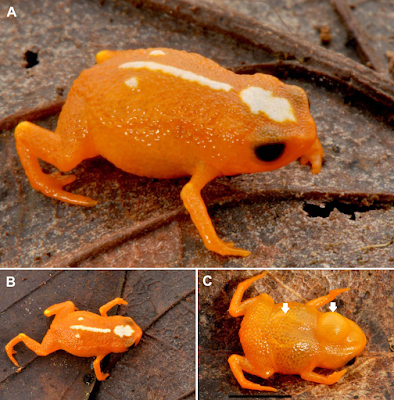 |
| Brachycephalus mirissimus
Pie, Ribeiro, Confetti, Nadaline & Bornschein, 2018
|
Abstract
A new miniaturized frog of the genus Brachycephalus (Anura: Brachycephalidae) is described from Morro Santo Anjo in the municipality of Massaranduba, Santa Catarina, southern Brazil. Specimens were collected from the leaf litter between 470 and 540 above sea level. The new species is distinguished from all its congeners by the combination of the following characters: (1) body robust and bufoniform; (2) size snout-vent length 9.9–11.7 mm for males and 10.0–12.9 mm for females; (3) smooth dorsum; (4) general color (in life) orange with white dots and stripe in the middle of the head and along its vertebral column; (5) iris completely black; (6) advertisement call composed of note groups; (7) isolated notes with 1–3 pulses; and (8) short isolated notes (0.002–0.027 s). An estimate of the male density of the new species is also presented. Phylogenetic information indicates that the new species is part of the southernmost clade of Brachycephalus, which includes Brachycephalus fuscolineatus, B. albolineatus, and B. boticario. The severe anthropogenic impacts in and around the type locality indicate that immediate actions should be taken to ensure the long-term preservation of the new species.
Brachycephalus mirissimus sp. nov.
Diagnosis. Brachycephalus mirissimus is a member of the genus Brachycephalus based on its position in a phylogenetic tree (Fig. 5). B. mirissimus is a member of the B. pernix group, as defined by Ribeiro et al. (2015) and modified above, by having a bufoniform body shape and linea masculina (Figs. 3C and 4H). B. mirissimus is distinguished from all of the species in the genus by the following combination of characters: (1) body robust and bufoniform; (2) size SVL 9.9–11.7 mm for males and 10.0–12.9 mm for females (Table 1); (3) smooth dorsum (Figs. 3 and 4); (4) general color (in life) orange with white dots and stripe in the middle of the head and along its vertebral column (Figs. 3 and 4); (5) iris completely black (Fig. 3A); (6) advertisement call composed of note groups; (7) isolated notes with 1–3 pulses; and (8) short isolated notes (0.002–0.027 s).
Phylogenetic relationships. The phylogenetic analysis of species of the B. pernix species group places B. mirissimus as part a clade which includes B. fuscolineatus and B. boticario (Fig. 5), which are the southernmost species of the genus and are distributed in the region of the new species (Fig. 6).
Habitat, abundance, and distribution. We recorded B. mirissimus calling throughout the day under the leaf litter, but with more intense vocal activity in the morning and later in the day. We did not hear the species throughout the study area, as it showed a patchy distribution, and it is not homogeneously abundant in these patches. In the patch where it appeared particularly abundant, we heard 14 males in 202 m2, resulting in one calling male per 14.5 m2.
The species is known from the type locality (Fig. 6), where it was found in a patchy distribution between 470 and 540 m a.s.l. in montane forest (Floresta Ombrófila Densa Montana; Fig. 8) that reaches about 18–28 m in height. We did not find the species in montane forest with a lower canopy (<10 m), which was in a very steep terrain. We estimate its “actual” extent of occurrence to be 56.8 ha (calculated excluding forested areas in very steep terrains). That estimate resulted in three in-line polygons, distant from each other by 190 and 60 m, which became isolated due to replacement of the original vegetation by Eucalyptus sp., Pinus sp. and palm plantations of Archontophoenix alexandrae H. Wendl. & Drude (Fig. 9; areas encompassed by polygons are 28.3, 23.1, and 5.4 ha). The historical extent of occurrence (i.e., before the deforestation) taken the above criteria, resulted in a continuous polygon of 111.8 ha.
...
Remarks. The type locality of B. mirissimus is 17.4 km distant in a straight line from the type locality of B. albolineatus, 18.9 km distant from the type locality of B. fuscolineatus, and 19.5 km distant from the type locality of B. boticario.
Marcio R. Pie, Luiz F. Ribeiro, André E. Confetti, Mário J. Nadaline and Marcos R. Bornschein. 2018. A New Species of Brachycephalus (Anura: Brachycephalidae) from southern Brazil. PeerJ. 6:e5683. DOI: 10.7717/peerj.5683








